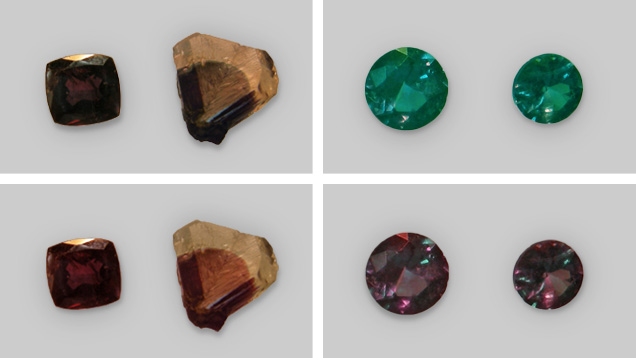“Red” Chrysoberyl versus Alexandrite: The Impact of Elevated Chromium Levels on Color and Color-Change Properties

Two samples displaying twinning, both from Brazil (one from Malacacheta, one without a specific locality), were investigated. Optical, micro-Raman spectroscopy, energy-dispersive X-ray fluorescence (EDXRF) spectroscopy, and electron microprobe techniques were used to characterize coloration, growth structures, inclusions, and trace-element chromophore distribution and amounts. The twinning present in both samples presented some difficulties in viewing color and pleochroism of the X, Y, and Z planes (parallel to the three crystallographic axes).As with alexandrite, the largest coloration difference exists in the Y plane. For this material, the color changed from yellowish orange in daylight to reddish orange in incandescent light, as opposed to alexandrite’s typically yellow-green to yellow-orange color change.
In characterizing quantitative data related to Cr and Fe, comparisons were made to data from “normal” Hematia and Malacacheta alexandrites. The reddish purple chrysoberyl was found to have higher Cr2O3 contents than “normal” Brazilian alexandrite from both localities. Alexandrite generally has Cr2O3 levels less than 1.0 % by weight and typically range from 0.4 to 0.7 wt.%, whereas the faceted reddish purple sample averaged 1.54 wt.% Cr2O3, with a wide 1.36–2.23 wt.% range. Furthermore, the faceted reddish purple chrysoberyl had an average iron content of 0.60 wt.% Fe2O3, comparable to “normal” samples from Malacacheta, but lower than average material from Hematita.
This elevation in Cr2O3 produces noticeably higher-intensity Cr3+ absorptions in the visible range that clearly diminishes how much transmission can occur in the absorption minimum around 490 nm in the blue-green region. Therefore, these crystals have a much less blue-green appearance in daylight than their more chromium-poor alexandrite relatives.
Much higher Cr2O3 levels have been documented in mostly nontransparent samples from other regions. A recently identified Cr analogue to chrysoberyl—Be(Cr,Al)2O4—contained 58 wt.% Cr2O3. This new mineral was named mariinskite after the Mariinsky mine, the largest emerald-alexandrite deposit in Russia’s Ural Mountains.



